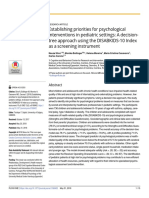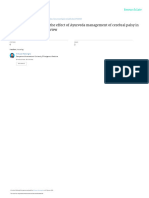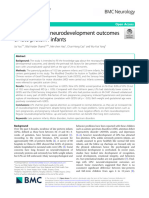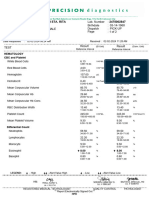Health-Related Quality of Life in Children With Ce
Health-Related Quality of Life in Children With Ce
Uploaded by
pkalikinkarojhaCopyright:
Available Formats
Health-Related Quality of Life in Children With Ce
Health-Related Quality of Life in Children With Ce
Uploaded by
pkalikinkarojhaOriginal Title
Copyright
Available Formats
Share this document
Did you find this document useful?
Is this content inappropriate?
Copyright:
Available Formats
Health-Related Quality of Life in Children With Ce
Health-Related Quality of Life in Children With Ce
Uploaded by
pkalikinkarojhaCopyright:
Available Formats
See discussions, stats, and author profiles for this publication at: https://www.researchgate.
net/publication/263321044
Health-related Quality of Life in Children with Cerebral Palsy and Their
Families.
Article in Indian Pediatrics · May 2014
DOI: 10.1007/s13312-014-0414-z · Source: PubMed
CITATIONS READS
44 697
5 authors, including:
Monica Juneja Rahul Jain
Lok Nayak Hospital Maulana Azad Medical College
117 PUBLICATIONS 1,591 CITATIONS 42 PUBLICATIONS 597 CITATIONS
SEE PROFILE SEE PROFILE
Smitha Sairam Dhananjeyan Thiagarajan
9 PUBLICATIONS 119 CITATIONS
RAGHAV PHYSIOTHERAPY AND RESEARCH CENTRE
1 PUBLICATION 43 CITATIONS
SEE PROFILE
SEE PROFILE
All content following this page was uploaded by Dhananjeyan Thiagarajan on 20 November 2018.
The user has requested enhancement of the downloaded file.
RESEARCH BRIEF
Health-related Quality of Life in Children with Cerebral Palsy and Their
Families
*MANJUSHA DOBHAL, MONICA JUNEJA, RAHUL JAIN, SMITHA SAIRAM AND *D THIAGARAJAN
From *Santosh College of Physiotherapy, Santosh Medical College and Hospital, Ghaziabad, UP; and Child Development Center,
Maulana Azad Medical College, New Delhi; India.
Correspondence to: Prof Monica Juneja, C-77, South Extension –II, New Delhi 110 049, India. drmonicajuneja@gmail.com
Received: August 22, 2013; Initial review: August 24, 2013; Accepted: March 06, 2014.
Objective: To determine the health-related quality of life in moderately-affected and 30% had severely-affected health-
children with cerebral palsy and their families. related quality of life. The physical independence, mobility and
social integration dimensions were much more severely affected
Methods: One hundred children (3-10 years of age) receiving
than the clinical burden, economic burden and schooling
regular rehabilitation therapy for cerebral palsy for last 1 year at a
dimensions.
Child Development Centrer were enrolled and the Lifestyle
assessment questionnaire – cerebral palsy was administered to Conclusion: Health-related quality of child is affected in most
the parents. children with cerebral palsy.
Results: 9% had good, 24% had mildly-affected, 37% had Keywords: Cerebral Palsy, Quality of life, Questionnaire.
uality of Life (QOL) has been defined by World After obtaining informed consent from the parents, a
Q Health Organization as an individual’s
perception of their position in life in the context
of the culture and value systems in which they
live, and in relationship to their goals, expectations,
detailed history was taken and neurological examination
was done. CP was classified based on the predominant
tone. Patients with spastic CP were further classified based
on the topography. The children were evaluated for
standards and concerns [1]. The more specific concept of accompanying impairments like seizures, hearing or vision
Health-related Quality of Life (HRQOL) has been impairments, cognitive deficits, feeding problems,
defined to differentiate health from more general social contractures and behavioural problems. Developmental
and environmental issues [2]. quotient/Intelligence quotient assessment and behaviour
assessment was done by a clinical psychologist. The
HRQOL is especially relevant to conditions that are probable aetiology was determined as per the history and
chronic and disabling such as cerebral palsy (CP) [3]. previous records.
There is a paucity of published literature on HRQOL in
children with CP, especially from the Indian The motor disability of the child was classified using
subcontinent. The present study determined HRQOL Gross Motor Functional Classification System (GMFCS)
using Lifestyle Assessment Questionnaire – Cerebral into 5 levels (Children with level I have the most
Palsy (LAQ-CP) [4]. independent motor function and the child in level V have
the least) [5].
METHODS
LAQ-CP questionnaire evaluates the impact of
This study was carried out at Child Development Center disability in children with CP and their families. It has 46
(CDC) of a tertiary care centre located in New Delhi. items, organized into six dimensions: physical
Children in the age group of 3-10 years diagnosed with independence, mobility, clinical burden, schooling,
cerebral palsy, and receiving regular (at least 1 visit every economic burden, and social integration [6]. Based on
6 weeks) physical therapy/occupational therapy at CDC scores in each item, dimensional scores and a final
for last one year were enrolled. The exclusion criteria standard score, known as Lifestyle Assessment Score
were non-availability of the primary caregiver, presence (LAS) is obtained. These are expressed as a percentage
of other chronic illnesses not typically associated with score. The classification of the HRQOL according to
cerebral palsy, and families having another child with LAS is as follows: Good (<30%); mildly-affected (30-
cerebral palsy, autism, or intellectual disability. 50%); moderately-affected (51-70%); and severely-
INDIAN PEDIATRICS 385 VOLUME 51__MAY 15, 2014
DABHOL, et al. CEREBRAL PALSY AND QUALITY OF LIFE
affected (>70%) [6]. demographic characteristics, types of CP, and probable
etiology are shown in Table I. Most of the patients had
Permission was taken from the authors of LAQ-CP to
associated co-morbidities: 31 (31%) had seizure
translate it into Hindi language. It was translated using
disorder, 37 (37%) had squint, 6 (6%) had cortical
back-translation method with necessary socio-cultural
blindness, 2 (2%) had hearing impairment, 81 (81%) had
modifications.
global developmental delay/intellectual disability (26
The sample size was based on a previous study, in mild, 19 moderate, 18 severe and 18 profound), 18 (18%)
which mean (SD) LAS was 45 (19) [7]. To estimate had behavior problems, 42 (42%) had drooling or other
similar LAS, with precision of 5% at 95% confidence feeding problems, and 4 (4%) patients had
level, 70 subjects were required. Data analysis was done contractures.The GMFCS level of patients was as
using SPSS version 16.0. The study protocol was follows: level I- 18 (18%), level II-12 (12%), level III-12
approved by the Institutional Ethics Committee. (12%), level IV-28 (28%) and level V-30 (30%).
RESULTS The mean dimensional scores are shown in Table II.
One hundred children (64 males) were enrolled, the mean Nine (9%) patients had good, 24 (24%) had mildly-
(95% CI) age was 61.0 (56.5,65.5) months. The socio- affected, 37 (37%) had moderately-affected, and 30
(30%) had severely affected HR-QoL.
LAS was significantly higher in boys as compared to
TABLE I BASELINE CHARACTERISTICS OF THE STUDY
girls [59.4 (16.7) vs. 50.4 (19.0), P=0.01]. No association
POPULATION (N = 100)
was found between LAS and socioeconomic status of the
Characteristics n (%) patient. LAS was significantly more in subjects with
quadriplegic CP, seizure disorder, visual problems,
Urban household 86 (86) cognitive deficits and feeding problems (data not shown).
Socio economic status* The Pearsons’ correlation coefficient of LAS and the
Upper class 2 (2) GMFCS levels was 0.907 (P<0.001).
Upper middle class 17 (17)
DISCUSSION
Lower middle class 32 (32)
Upper lower class 49 (49) In the present study, HRQOL was moderately to severely
Type of cerebral palsy affected in two-third of children with CP, and their
Spastic 83 (83) families. The physical independence, mobility and social
integration dimensions of HRQOL were much more
Quadriplegia 32 (39)
severely affected than the clinical burden, economic
Diplegia 35 (42) burden and schooling dimensions. Higher LAS in
Hemiplegia 15 (18) children with quadriplegic CP was expected as they have
Triplegia 1 (1) significant activity limitation and associated co-
Hypotonic 4 (4) morbidities like epilepsy and cognitive deficits [7].
Ataxic 3 (3)
A study from Malaysia [8] using the same
Choreoathetoid 1 (1) questionnaire reported good HRQOL in the majority, and
Mixed: Spastic and athetoid 3 (3) only 11.1% having severely-affected HRQOL. The better
Mixed: Spastic and dystonic 6 (6)
Probable etiology TABLE II MEAN DIMENSIONAL SCORES OBTAINED IN LAQ-CP
Hypoxic-ischemic encephalopathy 40 (40)
Dimensions Mean score (95% CI)
Prematurity 26 (26)
Kernicterus 7 (7) Physical independence 62.6 (57.2- 68.0)
Congenital hydrocephalus 4 (4) Mobility 59.1 (54.3-63.9)
Post-meningitic sequalae 5 (5) Clinical Burden 18.5 (17.0-20.0)
Brain tumor (Operated) 1 (1) Schooling 28.9 (25.7-32.1)
Head trauma 1 (1) Economic burden 33.7 (31.1-36.3)
Not known 16 (16) Social integration 47.6 (44.6-50.6)
* According to Kuppuswamy classification. Combined 56.6 (53.0-60.2)
INDIAN PEDIATRICS 386 VOLUME 51__MAY 15, 2014
DABHOL, et al. CEREBRAL PALSY AND QUALITY OF LIFE
WHAT THIS STUDY ADDS
• Health related Quality of Life is significantly affected in majority of children with cerebral palsy and their families.
QOL in this study could have been due to difference in life in young children. Child Care Health Dev.
severity, psychosocial factors and availability of the 2000;26:401-13.
health care services.Other studies done worldwide show 3. Davis E, Shelly A, Waters E, Boyd R, Cook K, Davern M,
that HRQOL is adversely affected in children with CP; et al. The impact of caring for a child with cerebral palsy:
quality of life for mothers and fathers. Child Care Health
however, majority of these studies have used generic
Dev. 2010;36:63-73.
QOL measures like ‘Child Health Questionnaire’ (CHQ) 4. Mackie PC, Jessen EC, Jarvis SN. The lifestyle assessment
and ‘Pediatric Quality of Life Inventory’ (PedQL). Varni, questionnaire: an instrument to measure the impact of
et al. [9] compared HRQOL across ten chronic disease disability on the lives of children with cerebral palsy and
clusters and 33 disease categories/severities, using their families. Child Care Health Dev. 1998;24:473–86.
PedsQL. Patients with CP self-reported the most 5. Palisano R, Rosenbaum P, Walter S, Russell D, Wood E,
impaired HRQOL across all disease categories [9]. Galuppi B. Development and reliability of a system to
Studies done using CHQ have also shown significant classify gross motor function in children with cerebral
impairment in most of the domains, especially so in palsy. Dev Med Child Neurol. 1997;39:214-23.
6. Mackie PC, Jessen EC, Jarvis SN. The Lifestyle
physical function and parental impact domain [10-14].
Assessment Questionnaire (LAQ-CP) Manual. Newcastle
LAQ-CP has limitations of not addressing some of upon Tyne: North of England Collaborative Cerebral Palsy
Survey, 1998.
the domains of QOL, as it specifically measures the
7. Singhi P. The child with cerebral palsy- clinical
impact of disability on the life of children with cerebral considerations and management. Indian J Pediatr.
palsy and their families.Being a single-center study, and 2001;68:531-6.
including a uniform population of children receiving 8. Yee Lim MS, Wong CP. Impact of cerebral palsy on the
regular therapy, findings may not be representative of the quality of life in patients and their families. Neurology
general population. Our study relied on parental report, Asia. 2009;14:27-33.
due to lack of a self-report version of the questionnaire; 9. Varni JW, Limbers CA, Burwinkle TM. Impaired health-
accurate measurement of HRQOL may have been related quality of life in children and adolescents with
compromised. chronic conditions: a comparative analysis of 10 disease
clusters and 33 disease categories/severities utilizing the
To conclude, HRQOL is significantly affected in PedsQL 4.0 Generic Core Scales. Health and Quality of
majority of children with cerebral palsy. Measurement of Life Outcomes. 2007;5:43.
10. Liptak GS, O’Donnell M, Conaway M, Chumlea CW,
HRQOL should be used with other forms of assessment,
Worley G, Henderson RC, et al. Health Status of children
to indicate areas in which a person is most affected and with moderate to severe cerebral palsy. Dev Med Child
help the practitioner in making appropriate decisions for Neurol. 2001;43:364-70.
patient care. 11. Wake M, Salmon L, Reddihough D. Health status of
Australian children with mild to severe cerebral palsy:
Contributors: MJ, MD, DT and RJ: conceptualizing and
cross-sectional survey using the Child Health
designing the study; MD and SS: acquition and analysis of data;
Questionnaire. Dev Med Child Neurol. 2003;45:194-9.
RJ, SS, and MD: prepared the initial draft; MJ, RJ and DT:
12. Vargus-Adams J. Health related quality of life in childhood
revised the manuscript critically for important intellectual
cerebral palsy. Arch Phys Med Rehab. 2005;86:940-54.
contents. The final version was approved by all authors.
13. Varni JW, Burwinkle TM, Sherman SA, Hanna K, Berrin
Funding: none; Competing interests: None stated.
SJ, Malcarne VL, et al. Health-related quality of life of
REFERENCES children and adolescents with cerebral palsy: hearing the
voices of the children. Dev Med Child Neurol.
1. The World Health Organization Quality of Life 2005;47:592-7.
Assessment (WHOQOL): Position Paper from the World 14. Majnemer A, Shevell M, Rosenbaum P, Law M, Poulin C.
Health Organization. Soc Sci Med. 1995;41:1403-9. Determinants of life quality in school-age children with
2. Eiser C, Mohay H, Morse R. The measurement of quality of cerebral palsy. J Pediatr 2007;151:470-475.
INDIAN PEDIATRICS 387 VOLUME 51__MAY 15, 2014
View publication stats
You might also like
- National AIDS Control ProgramDocument29 pagesNational AIDS Control ProgramMonalisha SinghNo ratings yet
- 00130478-202105000-00006 Serial Neurologic Assessment in Pediatrics (SNAP) : A New Tool For Bedside Neurologic Assessment of Critically Ill ChildrenDocument13 pages00130478-202105000-00006 Serial Neurologic Assessment in Pediatrics (SNAP) : A New Tool For Bedside Neurologic Assessment of Critically Ill ChildrenYo MeNo ratings yet
- Enteral Stenting: How, Why and When?Document25 pagesEnteral Stenting: How, Why and When?Nikhil BhangaleNo ratings yet
- DI jovens problemasDocument15 pagesDI jovens problemasLeonardo SchenckelNo ratings yet
- Behavior profile of children with nephrotic syndromeDocument6 pagesBehavior profile of children with nephrotic syndromeShubham ChauhanNo ratings yet
- Jurnal 6Document13 pagesJurnal 6dewi pspta sriNo ratings yet
- Develop Med Child Neuro - 2009 - WATERS - Quality of Life Instruments For Children and Adolescents With NeurodisabilitiesDocument10 pagesDevelop Med Child Neuro - 2009 - WATERS - Quality of Life Instruments For Children and Adolescents With NeurodisabilitiesCalin PirvaNo ratings yet
- (Pritchard2013) Incremental Validity of Neuropsychological Assessment in The Identification and Treatment of Youth With ADHDDocument25 pages(Pritchard2013) Incremental Validity of Neuropsychological Assessment in The Identification and Treatment of Youth With ADHDFariNo ratings yet
- Establishing Priorities For Psychological Interventions in Pediatric Settings: A Decision - Tree Approach Using The DISABKIDS-10 Index As A Screening InstrumentDocument15 pagesEstablishing Priorities For Psychological Interventions in Pediatric Settings: A Decision - Tree Approach Using The DISABKIDS-10 Index As A Screening InstrumentAndrade GuiNo ratings yet
- Pep RDocument12 pagesPep Rnays meetNo ratings yet
- To Investigate the Association between Sleep Quality and Mental Health among Students of the University of Hyderabad: A Cross-Sectional StudyDocument5 pagesTo Investigate the Association between Sleep Quality and Mental Health among Students of the University of Hyderabad: A Cross-Sectional StudyInternational Journal of Innovative Science and Research TechnologyNo ratings yet
- Research in Developmental DisabilitiesDocument11 pagesResearch in Developmental DisabilitiesmeraahitaNo ratings yet
- neurosurgery perception_pediatricDocument5 pagesneurosurgery perception_pediatricAchille DoleagbenouNo ratings yet
- DR NuwanSMarasinhgacpaetyparticleDocument18 pagesDR NuwanSMarasinhgacpaetyparticleSanjanaNo ratings yet
- Aphasia Fo 2Document14 pagesAphasia Fo 2pokharelriwaj82No ratings yet
- HHS Public AccessDocument25 pagesHHS Public AccessNurul SholehahNo ratings yet
- Psychometric Properties of Conversion Disorder Scale-Revised (CDS) For ChildrenDocument6 pagesPsychometric Properties of Conversion Disorder Scale-Revised (CDS) For ChildrenAsif BalochNo ratings yet
- Providing Effective Supervision in Clinical NeuropsychologyDocument23 pagesProviding Effective Supervision in Clinical NeuropsychologyZamira BarguilNo ratings yet
- Mount Sinai J Medicine - 2011 - Rosen - Geriatric Assessment ToolsDocument9 pagesMount Sinai J Medicine - 2011 - Rosen - Geriatric Assessment Toolsmonica ratnasariNo ratings yet
- Lau 2021Document12 pagesLau 2021Kevin LunaNo ratings yet
- 1 MultimethodassessmentDocument8 pages1 MultimethodassessmentRoberto Alexis Molina CampuzanoNo ratings yet
- 1 s2.0 S1877065714017989 MainDocument13 pages1 s2.0 S1877065714017989 MainMaría José Ruiz PastorNo ratings yet
- Early Intervention: Environmental or Experimental Factors The First 5 Years of LifeDocument55 pagesEarly Intervention: Environmental or Experimental Factors The First 5 Years of Lifeshruti kumar100% (1)
- The Positive Mental Health Instrument: Development and Validation of A Culturally Relevant Scale in A Multi-Ethnic Asian PopulationDocument19 pagesThe Positive Mental Health Instrument: Development and Validation of A Culturally Relevant Scale in A Multi-Ethnic Asian PopulationFebrio IglesiasNo ratings yet
- Advance Care Planning in Parkinson 'S Disease: Ethical Challenges and Future DirectionsDocument7 pagesAdvance Care Planning in Parkinson 'S Disease: Ethical Challenges and Future DirectionsJoana Brazão CachuloNo ratings yet
- A Clinical Pathway To Standardize Care of Children With Delirium in Pediatric Inpatient Settings-2019Document10 pagesA Clinical Pathway To Standardize Care of Children With Delirium in Pediatric Inpatient Settings-2019Juan ParedesNo ratings yet
- 31518028ddb3a2d814b6bdc5288a7faeDocument13 pages31518028ddb3a2d814b6bdc5288a7faeHadeel khaledNo ratings yet
- Developmental Psychopathology Check List For Children DPCL A Preliminary Report 1 9Document8 pagesDevelopmental Psychopathology Check List For Children DPCL A Preliminary Report 1 9triashaNo ratings yet
- Do Early Intervention Programmes Improve Cognitive and Motor Outcomes For Preterm Infants After Discharge A Systematic ReviewDocument9 pagesDo Early Intervention Programmes Improve Cognitive and Motor Outcomes For Preterm Infants After Discharge A Systematic ReviewJuan Carlos Jiménez FosadoNo ratings yet
- 2470 PDFDocument8 pages2470 PDFPreetha Kumar AJKKNo ratings yet
- QV STUDY 2012 Quality of Life of Methilfenidate Treatment - Pin-ChenDocument6 pagesQV STUDY 2012 Quality of Life of Methilfenidate Treatment - Pin-ChenDoniLeiteNo ratings yet
- Double Blind Placebo Controlled Randomized Study of Standardized Bacopa Monniera Extract in Children With Attention Deficit Hyperactivity DisorderDocument16 pagesDouble Blind Placebo Controlled Randomized Study of Standardized Bacopa Monniera Extract in Children With Attention Deficit Hyperactivity Disorder1mcryptocapitalNo ratings yet
- Perceptions about children and adolescentsDocument18 pagesPerceptions about children and adolescentsMarcélia Amorim CardosoNo ratings yet
- Ijhbr January 2018 11-16Document6 pagesIjhbr January 2018 11-16Chinni ChinnaNo ratings yet
- Geriatric Assmt ToolDocument9 pagesGeriatric Assmt ToolANITTA SNo ratings yet
- A Description of Preschool Neuropsi AssessmentDocument27 pagesA Description of Preschool Neuropsi AssessmentTatiana VasquesNo ratings yet
- Original ArticlesDocument7 pagesOriginal ArticlesĐan TâmNo ratings yet
- Tarren Sweeney2013Document15 pagesTarren Sweeney2013VictoriaNo ratings yet
- A Systematic Review of Psychosocial Interventions For Children and Young People With EpilepsyDocument40 pagesA Systematic Review of Psychosocial Interventions For Children and Young People With EpilepsyFERNANDO ALVESNo ratings yet
- Neuropsychological Assessment in Children and AdolescentsDocument13 pagesNeuropsychological Assessment in Children and AdolescentsPradeep100% (1)
- Epilepsy & Behavior: Shanna M. Guilfoyle, Sally Monahan, Cindy Wesolowski, Avani C. ModiDocument6 pagesEpilepsy & Behavior: Shanna M. Guilfoyle, Sally Monahan, Cindy Wesolowski, Avani C. ModiJhonny BatongNo ratings yet
- AnsiedadeDocument15 pagesAnsiedadeTayná MayerNo ratings yet
- Autism Spectrum Disorder and Behavioral InterventiDocument9 pagesAutism Spectrum Disorder and Behavioral InterventiWesley RiannNo ratings yet
- Neuroxpsychological Assessment of Psychogeriatric Patients With Limited EducationDocument11 pagesNeuroxpsychological Assessment of Psychogeriatric Patients With Limited Educationmacarena.isebNo ratings yet
- Loewy2012 - Prodromal Psychosis Screening in Adolescent Psychiatry ClinicsDocument7 pagesLoewy2012 - Prodromal Psychosis Screening in Adolescent Psychiatry ClinicsLuz María Sánchez ANo ratings yet
- JPP - Volume 5 - Issue 1 - Pages 4193-4208Document16 pagesJPP - Volume 5 - Issue 1 - Pages 4193-4208pegahparisa64No ratings yet
- Develop Med Child Neuro - 2007 - Varni - The PedsQL in Pediatric Cerebral Palsy Reliability Validity and Sensitivity ofDocument8 pagesDevelop Med Child Neuro - 2007 - Varni - The PedsQL in Pediatric Cerebral Palsy Reliability Validity and Sensitivity oftptjqd96j6No ratings yet
- Recommended Measures For The Assessment of Behavioral Disturbances Associated With DementiaDocument13 pagesRecommended Measures For The Assessment of Behavioral Disturbances Associated With DementiaaureliasartikaNo ratings yet
- PIIS2213398416300380Document6 pagesPIIS2213398416300380LiliNurmawatiNo ratings yet
- Association of Use of Different Type of Manual Therapy Approach With Upper Extremity Pain in Manual Therapists of LahoreDocument9 pagesAssociation of Use of Different Type of Manual Therapy Approach With Upper Extremity Pain in Manual Therapists of LahoreInternational Health ReviewNo ratings yet
- jamapsychiatry_osborn_2021_oi_210028_1628043324.91149 - 2025-01-04 14-32-00Document9 pagesjamapsychiatry_osborn_2021_oi_210028_1628043324.91149 - 2025-01-04 14-32-00shaimaa.refaatNo ratings yet
- Novak2013 PDFDocument26 pagesNovak2013 PDFRifa YulitaNo ratings yet
- Novack Etal2013Document43 pagesNovack Etal2013eebook123456No ratings yet
- 2019 Article 1336Document6 pages2019 Article 1336Eduardo LimaNo ratings yet
- Cognitive_Changes_and_Quality_of_Life_in_NeurocystDocument8 pagesCognitive_Changes_and_Quality_of_Life_in_Neurocystyandaarifqimm110503No ratings yet
- Early InterventionDocument12 pagesEarly InterventionDanilo LucasNo ratings yet
- 2013 - Novak - Interventions For Children With CPDocument26 pages2013 - Novak - Interventions For Children With CPFriendlymeNo ratings yet
- Health Literacy Risk in Older Adults With and Without Mild Cognitive ImpairmentDocument6 pagesHealth Literacy Risk in Older Adults With and Without Mild Cognitive ImpairmentEarn PPNo ratings yet
- Scherer Et Al. - Mental Health Support For Children and Adolescents With Hearing LossDocument11 pagesScherer Et Al. - Mental Health Support For Children and Adolescents With Hearing LossPablo VasquezNo ratings yet
- Tugas Jurnal Pediatric Feeding DisorderDocument26 pagesTugas Jurnal Pediatric Feeding DisorderhazerdNo ratings yet
- Of Living With Cerebral Palsy.: Glasgow Theses Service Theses@gla - Ac.ukDocument166 pagesOf Living With Cerebral Palsy.: Glasgow Theses Service Theses@gla - Ac.ukTeodora BortesNo ratings yet
- Critical Care for Anorexia Nervosa: The MARSIPAN Guidelines in PracticeFrom EverandCritical Care for Anorexia Nervosa: The MARSIPAN Guidelines in PracticeNo ratings yet
- SUSPENSION THERAPY MCQs by PhysiogkDocument3 pagesSUSPENSION THERAPY MCQs by PhysiogkpkalikinkarojhaNo ratings yet
- Activities in AgingDocument105 pagesActivities in Agingpkalikinkarojha100% (1)
- ChondromaDocument20 pagesChondromapkalikinkarojhaNo ratings yet
- Orthopaedic TerminologiesDocument57 pagesOrthopaedic TerminologiespkalikinkarojhaNo ratings yet
- 02 Investigations and SurveillanceDocument1 page02 Investigations and SurveillancepkalikinkarojhaNo ratings yet
- Transplantation of The Liver. 3rd Edition. ISBN 1455702684, 978-1455702688Document23 pagesTransplantation of The Liver. 3rd Edition. ISBN 1455702684, 978-1455702688hyacinthiaadoreelt100% (13)
- Chemical Pathology Reader UCT 2023 Formated 19 Jan 23Document481 pagesChemical Pathology Reader UCT 2023 Formated 19 Jan 23tmudzudzu11No ratings yet
- Body at Home by Jorge Cruise - ExcerptDocument44 pagesBody at Home by Jorge Cruise - ExcerptCrown Publishing Group86% (35)
- Estrada, Elizabeth Sta. Rita 2475002847Document7 pagesEstrada, Elizabeth Sta. Rita 2475002847jbeeestrada658No ratings yet
- Questions - Listening Practice 1Document7 pagesQuestions - Listening Practice 1yaseeNo ratings yet
- The Air That We BreathDocument1 pageThe Air That We BreathHuiNo ratings yet
- Intervention Plan and Activities: FOR Health 9Document4 pagesIntervention Plan and Activities: FOR Health 9Richard MarquezNo ratings yet
- Awareness of HypertensionDocument17 pagesAwareness of HypertensionARAVINDH R MNo ratings yet
- The 21 Principles of Smile Design: Your Guide To A More Attractive Confident SmileDocument24 pagesThe 21 Principles of Smile Design: Your Guide To A More Attractive Confident SmileMonika JadhavNo ratings yet
- Hepatitis B & C & D VirusDocument14 pagesHepatitis B & C & D VirusAtheer AlabdyNo ratings yet
- Employee Health and Personal Hygiene HandbookDocument45 pagesEmployee Health and Personal Hygiene HandbookAsma OmarNo ratings yet
- HEP2GO Carpal Tunnel Program PDFDocument2 pagesHEP2GO Carpal Tunnel Program PDFBetty OberackerNo ratings yet
- Algorithms For Nutritional Care: HIV/AIDS Medical Nutrition TherapyDocument40 pagesAlgorithms For Nutritional Care: HIV/AIDS Medical Nutrition Therapykashish guptaNo ratings yet
- Chemistry Project To Determine Which Antacid Neutralizers Stomach Acid MostDocument4 pagesChemistry Project To Determine Which Antacid Neutralizers Stomach Acid MostAnsia MeenazNo ratings yet
- 1 - The Management of Adenovirus Infection in The Children's Hospital From GalatiDocument7 pages1 - The Management of Adenovirus Infection in The Children's Hospital From GalatiGhimpu DanielaNo ratings yet
- Recall 20-21 JunyDocument131 pagesRecall 20-21 JunyNicole VinnikNo ratings yet
- How To Diagnose PROM & PPROM - Cahara AdhiDocument20 pagesHow To Diagnose PROM & PPROM - Cahara AdhiAmarendra Wardhana100% (1)
- Group 4 NCM 114Document14 pagesGroup 4 NCM 114ESTELLE VERA O. VELEZNo ratings yet
- SalmonellosisDocument26 pagesSalmonellosiscrazieelorraNo ratings yet
- Medicinal Chemistry 2 Unit 2Document2 pagesMedicinal Chemistry 2 Unit 2KevalNo ratings yet
- Gene TherapyDocument9 pagesGene TherapySumaNo ratings yet
- Download full CURRENT Diagnosis & Treatment Pediatrics 24th Edition Edition William Hay ebook all chaptersDocument66 pagesDownload full CURRENT Diagnosis & Treatment Pediatrics 24th Edition Edition William Hay ebook all chaptersveretatabbal100% (3)
- Mark Schemes: Quick Quiz Matching End of Unit Test Marks To NC LevelsDocument2 pagesMark Schemes: Quick Quiz Matching End of Unit Test Marks To NC LevelsVictor Barber Sanchis50% (10)
- Basics Arthroplasty ShrinandDocument420 pagesBasics Arthroplasty ShrinandPon Aravindhan A S100% (2)
- Bovine LamenessDocument4 pagesBovine LamenessmohsinNo ratings yet
- NCPDocument7 pagesNCPRuth MontebonNo ratings yet
- For Lab PostDocument3 pagesFor Lab PostChitradevi NatarajanNo ratings yet
- Panugalinog Genesis A. BSHM 2b Bmec Final1Document15 pagesPanugalinog Genesis A. BSHM 2b Bmec Final1Gerard Flor De LisNo ratings yet






























































































